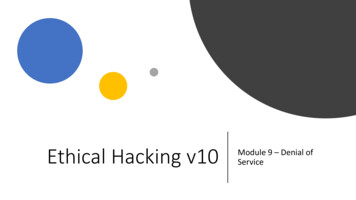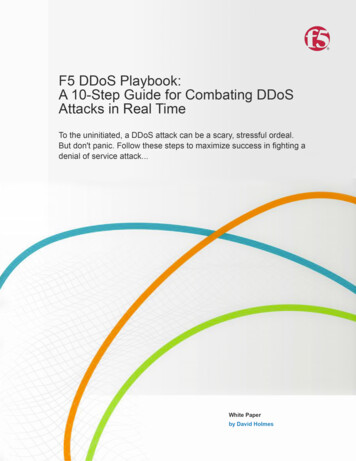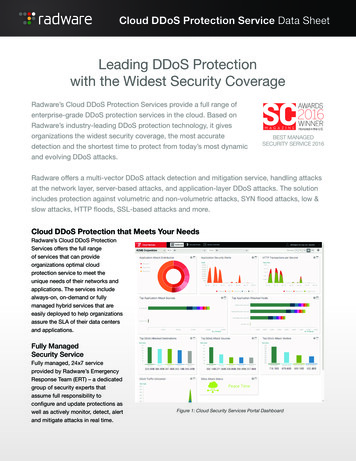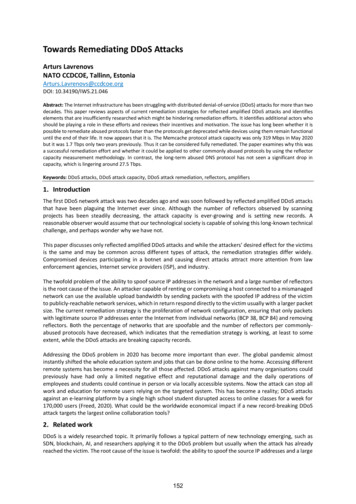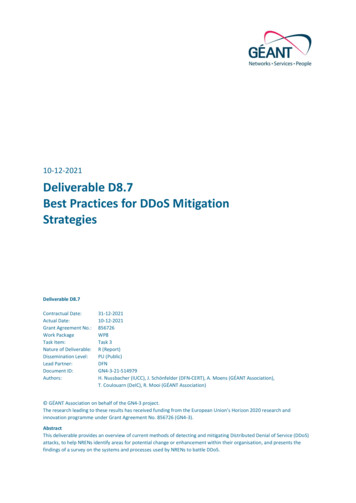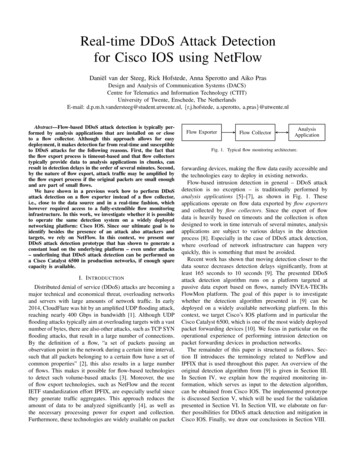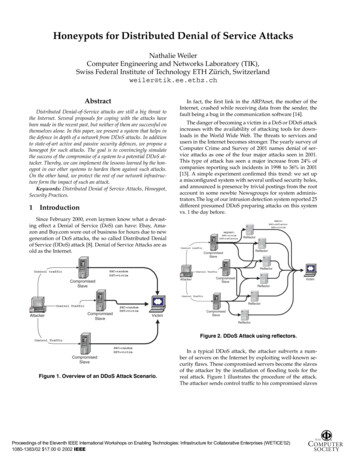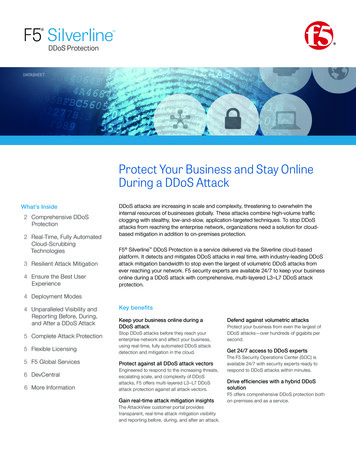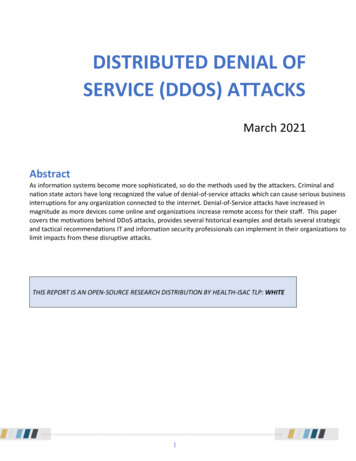
Transcription
DISTRIBUTED DENIAL OFSERVICE (DDOS) ATTACKSMarch 2021AbstractAs information systems become more sophisticated, so do the methods used by the attackers. Criminal andnation state actors have long recognized the value of denial-of-service attacks which can cause serious businessinterruptions for any organization connected to the internet. Denial-of-Service attacks have increased inmagnitude as more devices come online and organizations increase remote access for their staff. This papercovers the motivations behind DDoS attacks, provides several historical examples and details several strategicand tactical recommendations IT and information security professionals can implement in their organizations tolimit impacts from these disruptive attacks.THIS REPORT IS AN OPEN-SOURCE RESEARCH DISTRIBUTION BY HEALTH-ISAC TLP: WHITE1
www.h-isac.orgTable of ContentsEXECUTIVE SUMMARY . 3IMPACTS TO THE THREAT LANDSCAPE . 3MOTIVATIONS . 4OBSERVED ACTIVITY . 4PROPENSITY TO CHANGE OBJECTIVES . 4RANSOMWARE GANG DDOS ADOPTION . 5THIRD-PARTY TARGETING . 5CloudFare Magic Transit . 5MobileIron Enterprise MDM . 6TAKEDOWN CAMPAIGNS . 6EMOTET . 6TRICKBOT . 7RISK AND IMPACT. 7HEALTHCARE OPERATIONS . 8PATIENT-CENTERED CARE & REPUTATION . 8CRITICAL INFRASTRUCTURE . 9MITIGATION STRATEGIES . 9CURRENT NETWORK DEFENSE TECHNIQUES . 9STRATEGIC DDOS MITIGATION TECHNIQUES . 11OPERATIONAL AND TECHNICAL DDOS MITIGATION TECHNIQUES. 13Prevent . 13Detect . 14React. 15Correct . 17CONCLUSION . 17REFERENCES . 182
Executive SummaryAs information systems become more sophisticated, so do the tactics, techniques and procedures (TTPs) usedby attackers. While the financially motivated perversion of DDoS attacks has been a tactic used since the late1990’s, the use of Ransom denial-of-service attacks has been largely adopted by cyber criminals since 2015.Ransome denial-of-service attacks, or RDoS, are usually initiated through extortion letters sent via email torecipients of varying positions within organizations. The letter conveys threats to bombard the victim’s networkwith unsolicited traffic within a certain number of days and advises of a relatively small attack to demonstratecapabilities for legitimacy. If victims do not pay the ransom, normally in the form of Bitcoin, the fee to stop theattack will increase with each day that passes without having received payment. In cases where the threat actorreceives no communications from the victim, they will often execute follow-on RDoS attacks ranging weeks tomonths later from the initial attack.Denial-of-Service attacks have increased in magnitude as more devices come online through Internet of Things(IoT) devices and organizations reinforce remote connectivity systems to supplement pre-existinginfrastructure. Threat actors sought to capitalize on the current threat landscape in 2020 as telework increasesin response to the novel coronavirus and efforts to encourage social distancing. Regardless of size, organizationsoften fail to exercise asset and inventory management best practices conducive to a thorough understanding oftheir attack surface. In addition, IoT devices often utilize default passwords and do not have sound securitypostures, making them vulnerable to compromise and exploitation. Infection of IoT devices often goesunnoticed by users, and an attacker could easily compromise hundreds of thousands of these devices toconduct a large-scale attack.Impacts to the Threat LandscapeDefending the health sector from threats is an ongoing challenge as adversaries appear to have endless attackmethodologies available. Of the large breadth of malicious methods, distributed denial-of-service (DDoS) andransom denial-of-service (RDoS) attacks have been frequently used by threat actors. In 2020, for instance,Digital Shadows researchers observed several attacks against the healthcare industry, most notably a March2020 DDoS attack against the US Health and Human Services Department operated by an unknown threat actorat a critical moment amid the coronavirus outbreak. According to research conducted by Digital Shadows, threemain trends that can be expected to persist throughout 2021 include leveraging IoT devices, offering DDoSservice solutions, and DDoS extortion. The persistent creation of malicious tools and the propensity to sell themon criminal markets to accommodate threat actor demand ensures that the playbooks of threat actors involvedin DDoS activity will continue to expand in tandem with attempts to mitigate the threat of such attacks.With a significantly large portion of organization staff having migrated to remote work in 2020, cyber criminalssought to exploit the growth of internet use and home working during the Covid-19 pandemic according toresearch conducted by NETSCOUT. The cybersecurity company’s ATLAS Security Engineering and ResponseTeam (ASERT) revealed it observed over 10 million attacks of this nature in 2020, which is around 1.6 millionhigher than the previous year. Details revealed that attack frequency increased 20% throughout 2020, but withthe exclusion of the pre-pandemic months including January through most of March, attack frequency grew by22% year-on-year. Analysis of the information disclosed that healthcare and other essential sectors choosing toshift to a more digital workforce in response to the pandemic were heavily targeted by cyber criminals.3
MotivationsFollowing a year riddled with attacks targeting organizations to disrupt and render enterprise operabilityuseless, there has been a sizeable return in DDoS and RDoS activity. Adversaries have been observed targetingcorporate networks with the intention to cause disruption and spread disinformation to undermine responsesto the pandemic involving vaccine research, distribution, and treatment administration. Other motivationsinclude the pursuit of financial gain as the rise in Bitcoin-to-USD prices, more than likely, encourage attackers ofvarying sizes to return or re-prioritize RDoS and DDoS extortion schemes. Oftentimes, this comes in the form ofthreat actor groups with sophisticated tools designed to disrupt or take down enterprise networks. Theseefforts are exacerbated by individuals acting as hacktivists or pranksters lacking the skills and time to invest increating their own tools leveraging malicious services offered on the dark web to achieve similar objectives.Observed ActivityPropensity to Change ObjectivesWith the ability to quickly change which sectors to target, based on newly discovered risks and vulnerabilities toexploit or motives influencing operations, cyber criminals have a host of different threat landscapes to attack.One historical example includes the targeting of banks in the finance sector in September 2012 and continuedfor nearly nine months in which a series of DDoS attacks was launched by Iranian nation-state backed threatactors. The cyberattacks hit nearly 50 US financial institutions in over 200 DDoS attacks, according to the USDepartment of Homeland Security (DHS). A Middle Eastern hacking group known as the Izz ad-Din al-QassamCyber Fighters claimed to be at the center of the attacks while US intelligence officials pointed at Iraniangovernment-linked hacker groups.Regardless of the origins of the executed disruptive attacks, numerous financial institutions including Bank ofAmerica, the New York Stock Exchange (NYSE), J.P. Morgan Chase, and others were specifically identified astargets. However, there was an abrupt stop of the attacks and those closely investigating the matter assessed itwas due in large part to the Iranian presidential election. According to the analyses of data collected by Google,the attackers potentially shifted operations to focus domestically on gathering intelligence about groups andindividuals supporting specific candidates. The influx of detected and disrupted email-based phishing campaignsaimed at compromising accounts of numerous Iranian users represents the agility of malicious operationsinfluenced by the climate of current or emerging global events. Since then, these threat actors have fortifiedtheir arsenal and have established a high degree of surveillance and control. This has enabled them to quicklypivot between targets and re-prioritize objectives when exploiting vulnerabilities specific to any sector threatlandscape.4
Ransomware Gang DDoS AdoptionIn an effort to encourage contact with the attacker, ransomware gangs have been observed adopting DDoSattack methods to increase the likelihood of receiving payment. As ransomware remains one of the biggestglobal cyber threats to healthcare, it is paramount that security personnel remain vigilant and aware of thetactics, techniques, and procedures operators will use to make a profit. Security researchers in October 2020,reported that ransomware gangs were beginning to utilize DDoS attacks against a victims’ network or websiteas a supplemental tool to force them to pay a ransom. At the time, the two operations using this new tacticwere SunCrypt and RagnarLocker. Increases to the current threat landscape provided ransomware gangs withnew attack surfaces to attempt to exploit and implement crippling tactics to strongarm organizations to payransom demands.With cyber criminals hoping to make the largest profit in the quickest amount of time, healthcare providers arelikely targets. Recently joining the trend of using DDoS attacks to extort payment from victims is the Avaddonransomware gang. Avaddon ransomware began operations in June 2020 after initiating spam campaigns thatglobally targeted users. The ransomware gang tried their hand in double extortion tactics when they sent athreatening ransom note to an undisclosed victim organization advising the organization had 240 hours tocooperate. Failure to do so would result in the exposure of its database, including personal data of customersand employees, as well as financial documents. According to the ransom note, the victim’s website was underDDoS attack, which would not stop until Avaddon was contacted.Third-Party TargetingCloudFare Magic TransitA new type of DDoS attack was previously identified by Cloudfare whose waves mimicked that of an acousticbeat. The acoustic beat-inspired attacks delivered a sustained wave-shaped DDoS pattern for at least eighthours. Codenamed “Beat,” after a term coined in the acoustics world to signify the interference of two differentwave frequencies, the attack launched a flood of packets whose rate was determined by an equationrepresenting the two waves. The cybercriminal behind the attack that targeted a Magic Transit customer mayhave utilized the method they did in an attempt to overcome Cloudflare's DDoS protection systems.Magic Transit protects entire IP subnets from DDoS attacks, while also accelerating network traffic as ituses Cloudflare's global network to mitigate attacks employing both BGP and GRE for routing andencapsulation. By using the unidirectional TCP state tracking machine, flowtrackd, the company was able todetect the attack as a flood of ACK packets that did not belong to any existing TCP connection and automaticallydropped them. In total, the adversary’s attack persisted for over 19 hours with an amplitude of 7 Mpps, awavelength of 4 hours and a peak of 42 Mpps. During the two days in which the attack took place, Cloudflaresystems automatically detected and mitigated over 700 DDoS attacks targeting the customer.5
MobileIron Enterprise MDMMobile Device Management (MDM) systems are used inside enterprises to manage employees’ mobile devices,by allowing system administrators to deploy certificates, applications, access-control lists, and wipe stolendevices remotely. One MDM in particular, MobileIron, was targeted by several threat actors after a securityresearcher informed the vendor about bugs which were patched in July 2020. Two of the three vulnerabilities,CVE-2020-15505 and CVE-2020-15506 were considered critical and had a 9.8 CVSSv3 score. The othervulnerability, CVE-2020-15507 received a rating of high and held a 7.5 CVSSv3 score. Exploitation of these CVEswould introduce security issues including remote code execution, authentication bypass, and arbitrary filereading respectively.In September 2020, a detailed write-up about the vulnerabilities was released in which other researcherscreated proof-of-concept exploits that later became publicly available via GitHub. Some vendors did not takeadvantage of the grace period provided to patch vulnerable systems, leaving them exposed to the potential forexploitation by threat actors. This led to subsequent attacks in which the first wave took place at the beginningof October 2020, according to detections by RiskIQ researchers. One attack in particular, reported by securityfirm Black Arrow, involved a threat actor attempting to hack into MobileIron MDM systems and install theKaiten DDoS malware. Other nefarious instances involved the exploitation of CVE-2020-15505 which the USNational Security Agency (NSA) listed as one of the top 25 vulnerabilities exploited by Chinese state-sponsoredhackers during that time. According to the NSA, Chinese threat actors were using the MobileIron vulnerability,in conjunction with others, to gain an initial foothold on internet-connected systems to pivot to internalnetworks. At the height of the vulnerabilities’ disclosure, more than 20,000 organizations, including severalFortune 500 companies, used its MDM solutions according to MobileIron making it one of the most dangeroussecurity flaws disclosed last year.Takedown CampaignsInternational task forces involving multiple law enforcement agencies, working in collaboration with privatesector companies, have partnered to secure the successful dismantling of the botnets used by cyber criminals tolaunch malware and DDoS attacks. Two such recent examples are mentioned below.EmotetOn January 27, 2021, after the two-year planning of a global law enforcement operation, the world’s mostprolific and dangerous malware botnet was taken down. Those involved included Europol, the FBI, the UK’sNational Crime Agency and others which resulted in investigators taking over infrastructure controlling Emotet.Machines that were infected by Emotet were directed to infrastructure controlled by law enforcement whichput an end to cyber criminals exploiting compromised systems and the propagation of malware. At the height ofits operations, Emotet was the cause of millions of dollars in damages experienced by state, local, tribal, andterritorial governments.6
Emotet first emerged as a banking trojan in 2014 and later evolved into one of the most powerful forms ofmalware used by cyber criminals. Emotet compromised Windows computer systems using backdoors viaautomated phishing emails that distributed malware-laden Word documents. Successful exploitation involvedaltering subjects of emails and documents to lure victims into opening them which led to the installation of themalware. Regular themes included invoices, shipping notices and information about the novel coronaviruspandemic. The investigation of Emotet also disclosed a database of stolen email addresses, usernames, andpasswords which Europol worked with Computer Emergency Response Teams (CERTs) to aid those infectedwith Emotet.TrickbotOn October 12, 2020, the collaborative efforts of Microsoft’s Defender team, FS-ISAC, ESET, Lumen’s Black LotusLabs, NTT, and Broadcom’s cyber-security division Symantec led to the takedown of the TrickBot botnet. Priorto the execution of the takedown, each participant conducted investigations into TrickBot’s backendinfrastructure of servers and malware modules. Microsoft, ESET, Symantec, and partners analyzed the contentproviding insight into the malware’s inner workings including all the servers the botnet used to control infectedcomputers and serve additional modules. Microsoft later took to legal proceedings as they provided theinformation, requesting control over TrickBot servers.With the court’s approval, Microsoft and partners were able to disable the IP addresses, render the content oncommand and control (C2) servers inaccessible, suspend all services to the botnet operators, and preventresidual efforts to purchase or lease additional servers. Around the time of TrickBot’s takedown, operators hadinfected more than one million computers in which some of the compromised systems included IoT devices. OnOctober 13, 2020, multiple sources reported that the TrickBot botnet survived the attempted takedown asoperators quickly spun up new infrastructure. The perseverance displayed by TrickBot operators and the abilityto quickly revive operations further solidifies the importance of exercising best security practices and remainingvigilant to secure critical infrastructure.Risk and ImpactThe increasing frequency, intensity, and scale of DDoS attacks poses a significant threat to the entire healthcareindustry with a reach spanning across every healthcare subsector. All healthcare entities, Health-ISAC membersincluded, face a multitude of potential risks caused by potentially crippling DDoS attacks. Below are a fewprominent areas within the healthcare industry that are essential to the availability and support of patientcentered care. Each subsection serves to provide an overview of the negative impacts caused by the disruptiveactivity of DDoS attacks.7
Healthcare OperationsCritical operations rely on the integrity and infallibility of services. Without these services, basic utilities woulddisrupt the intake, processing, and outgoing care of patients, suppliers, and employees. The disruption ofessential healthcare operations by DDoS attacks can cause: Loss of Life: Disruption of essential care and supplies being delivered to vulnerable patients via a DDoSattack can potentially cause the worst outcome of a disruption of healthcare operations; loss of patientlife. Patients being admitted to hospitals in critical condition and in need of immediate access to care orthe safety and integrity of surgical procedures are matters highly considered to be at risk whenconsidering potential impacts to HDO services. Disruptions to Telemedicine: With increases to telehealth in 2020 due to Covid-19 social distancingefforts, patients and clinicians are heavily relying on the support and protection of infrastructure thatallows this method of long-distance communication. Disruptions to this remote service could bedevastating to some populations that have benefited tremendously due to its quality, access, and morepersonalized delivery.Patient-Centered Care & ReputationThe practice of patient-centered care is compartmentalized into different process functions to administermedical attention that is meaningful and valuable to both patients and their families. The process functionsinclude assessment, diagnosis, planning, implementation, and evaluation. In all, the aforementioned processfunctions are critical to the quality of patient care and significantly impacts the reputation of healthcareproviders in which adverse effects can lead to the following: Reduced Efficiency: The technological advances of today’s time has increased the efficiencies of medicalprofessionals all around the world as tasks have become more streamlined and automated. Digitalmedical systems including electronic medical records (EMRs), picture archiving and communicationsystems (PACs), remote patient monitoring systems, as well as infusion and insulin pumps are commonlyused tools in healthcare environments. In the event of a sustained DDoS attack, the risks associated withlosing access to systems is damaging from both an operational and financial standpoint.When systems become unavailable, employees are forced to implement manual processes to fulfillduties including checking patients’ vital signs, administering dosages, or access to properly functioningimaging equipment are a few of the many areas that would be noticeably impacted. The time it wouldgenerally take an employee to complete daily tasks will increase, effecting staff’s ability to administercare to others. In addition to the loss of these systems, organizations will have to address the financialimpacts that come with the total cost of ownership (TCO) and recovery after downtime.8
Loss of Credibility: Healthcare entities, staff, and patients alike, all want to be certain that medicalassistance is not only efficient, but consistently available to readily provide access to care. Failure tomaintain medical equipment uptime is detrimental to the capability of providing care and ultimatelyeffects the organization’s reputation both internally and externally. Both prospective employees andpatients, respectively, will refrain from seeking employment or medical assistance from organizationswhose reputation has been soured from the inability to exhibit resilience against negative outsideforces. Ultimately, organizations may be seen as unfit to provide the best care possible and experience aloss in human capital.Critical InfrastructureThe systems and networks that make up the infrastructure for organizations provides the foundation thatcritical operations require. Disruptions to critical infrastructure can have dire consequences that span across theorganization and can impact: Access to Corporate Resources: Due to the massive increase in the remote workforce, demands toensure business continuity by providing remote users with access to essential corporate applications andservices is at an all-time high. Now more than ever, a relatively minor DDoS attack could bring down aremote employee access / Virtual Private Network (VPN) gateway, preventing access to tools andsystems necessary to employee job functions. Threat actors are aware organizations are more exposedwhile employees are working remotely especially as a result of the ongoing pandemic in 2020 and 2021.As a result, it is important that IT departments leverage tools necessary to maintaining load balancingbest practices to avoid VPN gateways from being overwhelmed and unable to provide required accessfor remote workers.Mitigation StrategiesOrganizations are encouraged to formulate denial-of-service response plans that are predicated on resilience,incorporating key elements including system checklists, response teams, and efficient communication andescalation procedures. It is equally important to remain vigilant in securing network infrastructure andpracticing basic network security for the purpose of establishing a standard that is recognized throughout theorganization. In addition, organizations should consider force multiplying mitigation efforts by leveragingstrategic relationships with entities such as ISACs, law enforcement initiatives, and governmental departmentsdedicated to the implementation of defense in depth controls.The following network defense and operational / technical mitigation techniques were borrowed from aFinancial Services ISAC publication, and provides a wealth of information relevant to the climate of today’sthreat landscape and the impacts of DDoS attacks. Each section details information regarding current networkdefense, strategic DDoS mitigation, and operational and technical DDoS mitigation techniques.Current Network Defense Techniques Blackhole routing – Blackhole routing is a technique used as far upstream as possible by diverting anddiscarding malicious network traffic destined for a targeted organization.9
Sinkhole routing – Sinkhole routing is a means of diverting traffic to an unused area of the network. This canprovide opportunity for monitoring and investigative analysis. Unicast Reverse Path Forwarding (uRPF) – This security feature works by enabling a router to verify the“reachability” of the source address in packets being forwarded. If the source IP address is not valid, thepacket is discarded. Geographic Dispersion (Global Resources Anycast) – A newer solution for mitigating DDoS attacks dilutesattack effects by distributing the footprint of DDoS attacks so that the target(s) are not individuallysaturated by the volume of attack traffic. This solution uses a routing concept known as Anycast, whichallows traffic from a source to be routed to various nodes (representing the same destination address) viathe nearest hop/node in a group of potential transit points. Reputation-Based Blocking – Reputation-based blocking limits the impact of untrustworthy URLs byproviding URL analysis incorporating world-wide threat telemetry, intelligence, and analytic modeling and adecision component which focuses on the reputation of a URL. Host-based Intrusion Detection System (IDS) – Intrusion Detection Systems are network devices thatmonitor, detect, and alert on malicious activities using signature or statistical anomaly based detectiontechniques. Intrusion Prevention System (IPS) – Intrusion Prevention Systems are network devices that monitor, detect,and prevent malicious activity using signature or statistical anomaly-based detection techniques. Signaturebased intrusion prevention systems rely on vendor threat signature updates which fail to keep up with thelatest DDoS threats. ACLs and Firewall Rules – ACLs provide day zero or reactive mitigation for DDoS attacks, as well as a firstlevel mitigation for application-level attacks. An ACL is an ordered set of rules that filter traffic. Firewalls,routers, and even switches support ACLs. DNS – DNS-related information can be correlated with other forms of telemetry (NetFlow, packet capture,application logs) to further investigate potential malicious behavior in the network. For example, there maybe a baseline level of DNS queries from certain sources and a spike or change can indicate pot
DISTRIBUTED DENIAL OF SERVICE (DDOS) ATTACKS March 2021 Abstract As information systems become more sophisticated, so do the methods used by the attackers. Criminal and nation state actors have long recognized the value of denial-of-service attacks which can cause serious business interruptions for any organization connected to the internet.
